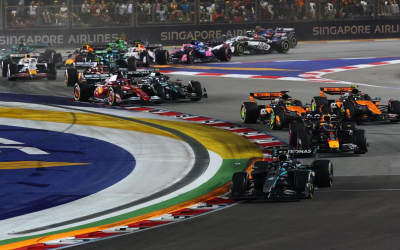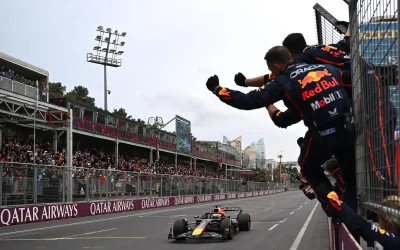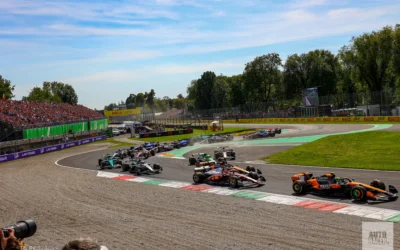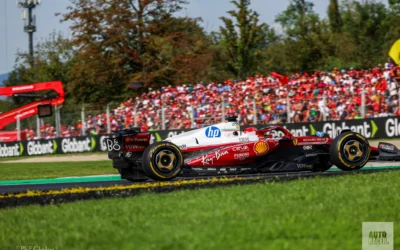Williams unveiled the new FW47 on Valentine’s Day, with Carlos Sainz and Alexander Albon completing their first laps in a damp Silverstone. The Grove outfit were second team, after McLaren, to take their 2025 challenger to track.
The technicians led by Pat Fry continued on the path they had traced in 2024, with a single-seater that appears to be the direct evolution of the one that raced in Abu Dhabi. Though lacking in major upheavals, there are some significant differences.
Williams: New front wing and nose design. Push-rod front suspension is confirmed.
The area of greatest apparent evolution is certainly the front. Consequently, this leads to changes in the central part of the car.
Williams engineers worked towards a design that could ensure greater aerodynamic load in the front end. As a result, the team confirmed suspicions they would bring a new front wing.
The FW47 features a mainplane with a shape more similar to those of rival teams. It aims to produce greater downforce centrally, with a pronounced spoon under the nose, developing an outwash effect towards the endplate.
Unlike last year, the external flap is far less pronounced than previous seasons.

There have also been changes to the nose which, like at McLaren, has been streamlined. Williams have worked on a different shape, featuring a wing with more pronounced curves an the end.
This area remains attached to the second element of the front wing, up to the chassis.
Williams continue with the front push rod scheme, going against the grain of almost the entire 2025 grid. There is no sign of a major research effort into the anti-dive effect or interaction between mechanics and aerodynamics.
Other teams, including McLaren, were doing this even at the end of 2024.
Ferrari, for example, kept the push rod on the SF-24 while still looking for a more advanced anti-dive effect. The Scuderia used their suspension’s arms as a function of aerodynamics.
The bonnet is the most modified part, the sidepods and inlets are an evolution of the 2024 concept
In the central area of the FW47, there are numerous modifications along the entire bodywork. Pat Fry and his personnel remain faithful to the concept of the shark inlets that ‘dominated’ the development of the past season.
They have worked to reduce the inlet volumes for greater overall efficiency of their ’25 challenger. This choice leads to a modification in the sidepods region.
Although it does not massively deviate from last season, the FW47 has a significant undercut – designed to energise flow towards the rear end. Williams have also incorporated a ‘slide’ above the sidepods that is less aggressive, more of a McLaren design.
A bigger change is seen in the sidepod’s shoulder edge, which is now higher. Technicians expect this to improve stability during corner rotation.
The biggest changes, however, are to be found on the engine cover, which is very different from the 2024 specification.
The air box has remained the same design, but behind it is a more pronounced tray. Williams intend for this to direct airflow to the rear area of the FW47, which has a slope towards the beam wing.
At McLaren, they have opted for a solution similar to that of the SF-24, further distancing themselves from last year’s Bazooka design.
Furthermore, you can see the upper part more tapered, with a small but longer ‘fin’. In the lower part – whilst much narrower last year – now features a more swollen area, similar to the general direction of rivals.
As always, it is complicated to analyse the inlet part of the Venturi channels. Still, a change in the SIS cover is evident, which remains drowned in the floor. This could mean a different distribution of downforce load.
After a year of carryover, Williams converts to pushrod rear
The situation at Williams is improving. This is demonstrated by James Vowles‘ personnel being right on schedule with the FW47’s launch.
Last season was a very different story, when it was a struggle to arrive in time for Bahrain Testing.
Vowles, however, makes no secret about prioritising the 2026 project, as they aim to climb the field.
For this reason, some pragmatic choices had to be made. There will be more of these in the future, especially in terms of budget cap and wind tunnel hours spent on the FW47.
Nevertheless, this has not prevented the team from updating their the rear suspension.
Last season, Williams continued with the pull rod scheme (like Ferrari and Haas) of 2023. This was for purely economic and development reasons, not wanting to wait for the production of a component that would have been produced relatively late – limiting time to work on the FW46.
This year, the situation is different and Williams has decided to ‘update’ its rear suspension. They have converted to the push-rod scheme (only Ferrari and Haas maintain the pull-rod) by purchasing this component from Mercedes.
By doing this, Williams go directly from the 2023 specification to the 2025 one. Because of this, the Grove team will enjoy the latest evolution from Mercedes and the Brackley factory.
Finally, it is interesting to note, that Sainz used two different rear wing specification on the FW47’s filming day. After initial using a high-downforce specification, the team moved to medium-low spec, more suited to a track like Silverstone.
There it is also a small, though still noticeable, modification to the edge of the mobile flap – which is not connected to the endplate.
Broadly speaking, this is consistent with the solutions other teams are working on.








